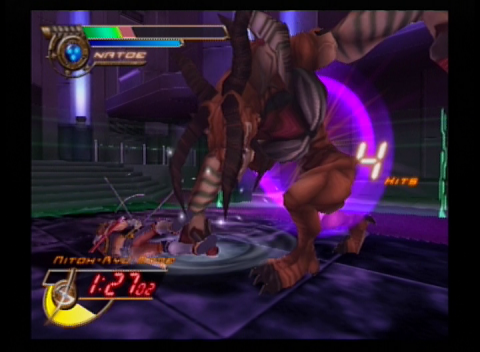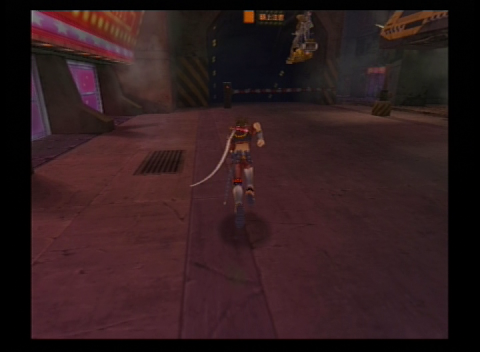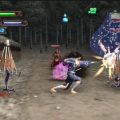Before even reaching the title screen of 2004’s PlayStation 2 release Seven Samurai 20XX, an enormous weight of expectation and confusion has already been placed upon a perspective player. The title alone, referring to one of the most internationally recognized and beloved historical epic films, written, edited and directed by Akira Kurosawa in 1954, provides a futuristic suffix that may’ cause pause. After the legendary director passed away in 1998, leadership of his longtime production company Kurosawa Productions, established in 1959 to help the director maintain artistic freedom over his projects, turned over to his son Hisao. In 2004, to celebrate the 50th anniversary of Seven Samurai, a variety of promotional campaigns and theatrical screenings were planned. An anime project titled Samurai 7 was produced, and Hisao Kurosawa turned towards the video game industry to put the Kurosawa name on a blockbuster release, an endeavor which became Seven Samurai 20XX.
The box proudly proclaims an array of bonafide talents, including a scored provided by “an Academy Award winning” composer, Ryuichi Sakamoto, a statement that sells his bountiful media-spanning career accomplishments somewhat short (Ryuichi is also the subject of a critically acclaimed biopic titled Coda that released in 2017; unsurprisingly, his work from Seven Samurai 20XX does not appear in the film). Also on display are character designs from Jean Giraud, AKA Mœbius, a French comic artist who had been producing influential illustrations, graphic novels and comic books for nearly half a century by the time Sammy Studios got him on board for Seven Samurai 20XX. Nestled away within his seemingly endless resume of science fiction and fantasy works are credits for the cover art of Panzer Dragoon and the PC release of Fade to Black, so he was no stranger to the world of video game development before this project. And finally, the developers tasked with coordinating this network of creative minds was Dimps, known both for their development of the modern-era Street Fighter games (IV, X Tekken and V), and the Game Boy Advance Sonic games, and also the seemingly endless stream of Dragon Ball Z licensed games, mainly the Budokai franchise and presently, the Xenoverse releases. The focus on stylish, high-speed samurai action seemed like a natural fit for the studio.
So against a mountain of cultural referents, layers of branding and internationally diverse artistic drives, what does Seven Samurai 20XX even do to live up to its own name? First and foremost is the games’ narrative and aesthetic departure from the source material. Obviously given the cyberpunk-leaning dating scheme in the title, Seven Samurai 20XX transplants the feudal peasant drama space to a technological hellscape, where humans (inhabiting the role of the beleaguered farmers from the original) are endlessly beset by “humanoids”, hulked-up cyborg freaks that resemble werewolves, robots and common street thugs interchangeably. Our casual hero Natoe gets roped into defending the weak humans alongside some old samurai friends. And really, outside of a numeral parallel, the game barely registers any hint of influence from the original film in the opening hours. When discussing plans to defend the human settlement, the elderly Kambei mutters “We’ll need six….no wait, make that seven samurai!”, as if you needed a reminder.
In the latter half, once the group of samurai have arrived at the village requesting their help, more obvious parallels are found, including a variety of scenes recreated almost shot for shot, swapping the muddy, crusty visages of the original samurai cast for a colorful array of teenage dweebs cracking wise. It’s ludicrous and galling in equal turns, and the narrative continues to swerve from here as one of the travelers, a pink-haired girl named Hinata, turns out to be the “Child of Heaven”, who the humanoids must to capture in order to utilize as an endless energy supply at their skyline-dominating urban headquarters.
Japanese flair abounds in the game’s UI design, with most menu options and HUD elements retaining untranslated kanji to play up the aesthetic. Oddly the translation seems to have been split in two, with the voice acted lines sounding fine, while much of the written, unspoken text from interacting with random citizens containing myriad typos and awkward phrasing. Notably, while everyone refers to the group of seven heroes as “samurai” in voice acted cut-scenes, they are always referred to as “hunters” in written script. These systemic mistakes make it seem like the spoken dialogue was given much better attention during the localization process.
The game is split into two distinct modes of control. Outside of combat, your interactions are limited to only a talk button, and these meandering interludes allow the game to develop its unique and somewhat excessive aesthetic design to be shown off. While the characters are a chaotic mess of clashing fashion sensibilities, the environments they occupy are disappointingly less-so. There are many, many brown hallways and squares in Seven Samurai 20XX, which is a shame considering the areas that are somewhat more detailed, like a fake “Kowloon City” replete with a mile-high casino mega-structure, and a teetering Greco-Roman arena protruding from a solitary cliff face, are a genuine joy to experience. Much of what you’ll be doing though, is running in straight lines, pausing frequently to engage in combat.
The mechanics of Seven Samurai 20XX are simple at first and become even shallower after just a handful of minutes squaring off with seemingly endless waves of nearly identical robots in the games’ opening chapters. Tapping or holding square (Seven Samurai 20XX is one of those rare PS2 games which take advantage of its analog face buttons) will unleash a series of sword swipes, weak or strong, while holding different directional inputs will reorient Natoe’s attacks. A surprisingly large combo list is included in the game’s pause screen, which shows off inputs inspired by fighting games, including charge moves (hold back and tap forward+square, for example) and 360 degree inputs. The difficulty of pulling off these moves are exacerbated by both the analog nature of the game constantly shifting Natoe’s position relative to enemies and by the undeniable power of just tapping square constantly. There’s no reason to pull off anything very technical when most enemies can’t even wind up an attack animation before exploding in a shower of fireworks.
Some additional mechanical layers take what was already a relatively simple button-mashing experience, akin to the zen-like endless destruction of a Dynasty Warrior‘s battlefield, and make it even easier. Natoe can enter a Ni-tou-ryu state (another bit of untranslated Japanese flavor) when a power-up bar has filled up. During this period Natoe pulls out a second sword and gets a “new” move list, which includes hitting the square button once, twice, three times, or, if you’re feeling saucy, a fourth time. Natoe effortlessly destroys everything on screen in Ni-tou-ryu, and by pointing the stick towards enemies, he will teleport next to them and keep a combo going.
You can also “guard” at any time by pressing triangle. During a sword swing, while taking damage, while on the ground, whenever. Guarding does not even have an animation associated with it, it’s more akin to passive state you can enable on the fly. Natoe flashes blue and burns a little bit of a guard meter under his health bar. During this guard state, Natoe will reflect any incoming enemy attack. Pull this off successfully while in Ni-tou-ryu, and the power-up bar refills to full, a technique called Just Guard. Since the window for a Just Guard is more forgiving than a doting grandmother, and you can guard at any point in any attack animation, you will spend 99% of your time in Ni-tou-ryu mode, teleporting around the screen, destroying everything and tapping triangle periodically to make yourself functionally invincible.
One-on-one boss encounters against enemy samurai or “Hunters”, cyborg humanoids sporting an array of peculiar designs, are actually easier than most encounters. The camera shifts to a side-view of the action, presenting these battles like a Tekken or Dead or Alive match, but the more obviously animated wind-ups and attack tells produced by the boss characters are even easier to Just Guard than any other attacks in the game. You will stand directly in front of them and whittle down their health in a minute or two without much trouble. Amusing highlights include the “Rap Bros” Chi & Mu, who open their battle with possibly the most embarrassing rapping scene in gaming history, and Jaguar Baller who just looks like a professional hockey player and materializes an ice-skating rink under his feet for one fleeting encounter.
While the simplicity of combat isn’t really a mark against the game in any sense on its own, especially since you’ll mainly be playing Seven Samurai 20XX to see how (or really, why) the game parallels the source material, the ultimate issue compounding all frustrations with the mechanical paucity is the game’s performance. The framerate during most encounters falls, without exaggeration, into the single digits. There are times where enough enemies and flashy affects appear on screen that you can basically count the frames as they load up. A wildly varying framerate does not let one easily time Just Guards with any real sense of satisfaction. By tapping triangle periodically the parry window could be as short as a split second or protect you for seconds at a time, depending on how dense the particular arena is. Even wandering through some of Seven Samurai 20XX‘s environments causing the game to slow to a crawl. Walk into a busy bar with too many patrons and you can watch the world fall apart on the fly by panning the camera over the crowd.
Additional small annoyances can be found in the save system, or lack thereof. You can only save your game by completing a chapter. Thankfully, the 11 chapters in the game are relatively short, unless you spend a long time getting lost in a series of identical looking hallways, criss-crossing environments trying to trigger the next cut-scene. Finally, there is a leveling system which enhances your health values, defensive meter or ni-tou-ryu time at the end of each level. This occurs with no input from the player. A stats summary page, which also helpfully lists the amount calories both Natoe and the one controlling him burned over the course of a chapter, ends with a “weakness coverage” bonus. End the chapter with less health and the game boosts it to help you out in the future. This is an interesting idea, adopting some of the dynamic difficulties utilized in other games like Crash Bandicoot or Resident Evil 4 and re-contextualizing it as an RPG leveling system for their action game. The issue with the weakness coverage mechanic is that is totally binary, only checking values at the last second of chapter completion. Since every level ends with a boss, its best to let them rough you up for a while before dealing the finishing blow if you want to maximize your strength. It’s ultimately unnecessary to worry about this in order to complete the game, as, alongside its easy difficulty, failure has no penalty. You can continue upon death with full health in whatever room or boss fight you fell in.
There are secret boss fights to discover and alternate weapon skins to find, and the game allows you to continue a New Game+ file on higher difficulties if you so choose. Finding every secret boss also unlocks a boss rush mode if you really want to spend an hour or two getting to know your square button better. Altogether, mind-numbing combat is a constant interruption in Seven Samurai 20XX, interfering with ones ability to witness the bizarre ways in which the original film has been filtered through decades of intervening artistic and media shifts. Moments like the introduction of a buxom love interest for Natoe, dressed in head-to-toe leather dominatrix gear, only to have her transformed into a demon and be unceremoniously killed off-screen by one of the titular samurai 15 minutes later should be a crazy joyride style experience, but the interstitial action just drags on forever. The weird confluence of licensing agreements and artistic stunt casting that produced Seven Samurai 20XX may never be recreated again, for better or for worse, and the game stands as a proud monument towards a very brief era of licensed wish-making happening on Sony’s hardware. There was a chance that some GameStop in 2005 had on its shelf the enticing choice between The Warriors and Seven Samurai for your PlayStation, products driven by large-scale ambitions to marry a storied cinematic history with a burgeoning video game one. Seven Samurai 20XX is best enjoyed the same way as its namesake: watch it, don’t play it.



